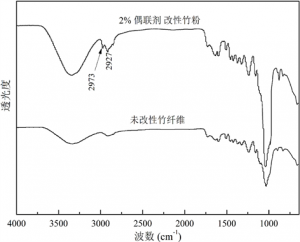In addition to its sustainable properties, bamboo also has better strength, toughness and hardness than wood. The researchers created a compound material with PP and bamboo by heating and plasticizing via an extruder, and then created composite parts using extrusion and injection molding.
“The modification of bamboo fiber by microorganisms, or the modification of fiber surface by bamboo fiber through maleic anhydride grafting, silane coupling, etc. is intended to improve the compatibility of fiber with plastic matrix,” the researchers state. “Add inorganic micro-nanoparticles or add binder to modify the mechanical properties of the material.”
The bamboo powder was dried and mixed with an aluminate coupling agent and a compatibilizer, and combined with the polypropylene matrix. The materials were mixed at high speed and then plasticized and granulated using a twin-screw extruder. The particles were then injection molded to prepare splines, and the mechanical properties of the parts were tested. The chemical structure of the material was analyzed by Fourier transform infrared spectroscopy, and the microscopic morphology of bamboo fiber and bamboo-plastic composites was observed by scanning electron microscopy. The bamboo powder and brittle broken bamboo plastic spline sections were observed after gold injection.

Scanning electron microscope of bamboo powder fiber (a) and composites containing 7 wt% bamboo powder (b)
The melt flow rate of the material was measured, as well as the Vicat softening point of the composite material. An impact strength test and a tensile strength test were carried out on the molded parts.
“It can be seen that the melt index of the composite decreases with the increase of bamboo-plastic ratio,” the researchers state. “It indicates that the addition of bamboo powder hinders the sliding between the PP molecular chains, and the greater the bamboo powder content, the worse the fluidity.”
They also found, however, that bamboo powder can increase the heat resistance of the composite. The impact strength also increases with an increase in bamboo powder, although the tensile strength was slightly decreased.
Overall, bamboo shows a great deal of promise when combined with a material like polypropylene. Because of its heat resistance, hardness, toughness and impact strength, it has the potential to be used as a valuable part of many 3D printing applications – not to mention that it produces an attractive wood-like finish. There is a great need for more sustainable 3D printing materials, and bamboo is one solution.
Authors of the paper include Pan Ting, Heguo Wen, Licheng Huang, Zhongtong Sheng, Hu Yongjun and Yin Guomin.
Discuss this and other 3D printing topics at 3DPrintBoard.com or share your thoughts below.
Subscribe to Our Email Newsletter
Stay up-to-date on all the latest news from the 3D printing industry and receive information and offers from third party vendors.
You May Also Like
NSF Awards Kentucky $1M for Advanced Manufacturing
The National Science Foundation has awarded a $1 million grant to the University of Louisville for the Advancing Manufacturing and Building Construction Technologies (NSF AMT) project. This initiative is part...
3D Printing News Briefs, May 11, 2024: 3D Printed Stent, Tower, Sculptures, & More
We’re starting off with medical research in today’s 3D Printing News Briefs, as researchers in Korea used CT images and 3D printing to fabricate an educational simulator for a mastoidectomy....
3D Printing Unpeeled: Wind Turbines, Probiotics and Lenses
TPI Composites, ORNL and Ingersoll Rand are working to make wind turbine tooling segments that can be 18.3 meters long. These elements also include resistive wires that help keep the...
Tethon 3D Releases Cost-effective Bioprinter
Tethon 3D, known for its ceramic-loaded DLP materials, custom resins, and DLP 3D printers, has recently released a bioprinter. Vat polymerization printers like DLP systems have been widely used by...


































